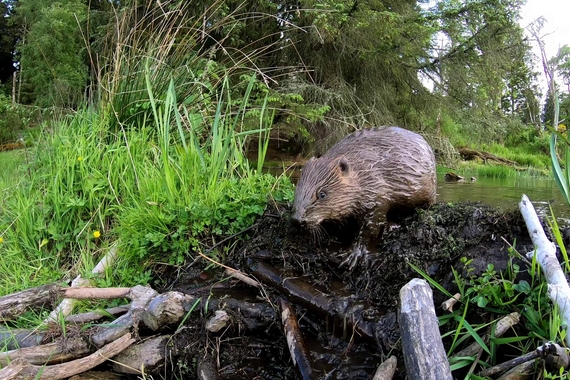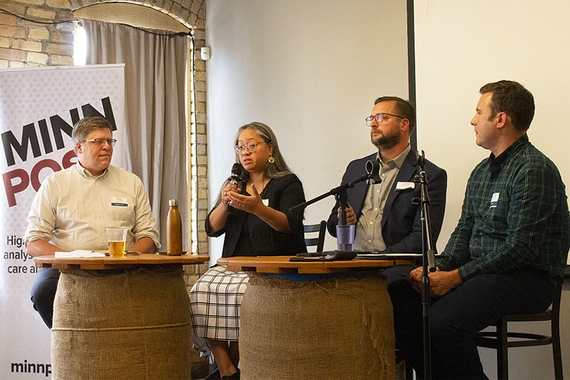The How and Why of Movement
Somayeh Dodge studied in Tehran, Iran. She received her PhD in Zurich, Switzerland. She did postdoctoral research at The Ohio State University and held an assistant professorship at the University of Colorado in Colorado Springs.
It’s perhaps fitting, then, that Dodge studies movement.
And she’s found a new place to continue her work: the University of Minnesota.
Finding Meaning from Observation
Dodge is coming up on her third year next August as assistant professor of Geographic Information Science (GIS).
Her work focuses on the ways individuals move in relation to their environment.
“My research mainly involves developing methods to look at how patterns are developed —[analyzing] patterns of individuals, animals, in general, any organism that moves—and looking at how movement patterns are influenced by the environment,” Dodge says.
In particular, Dodge works to develop research methods that help explain and, ideally, predict an organism’s trajectory. She turns hard data into computational models and visualizations, such as 3-D and animated maps. Essentially, Dodge works to find meaning from raw observations.
It helps that Dodge has a wide-ranging academic background. Her undergraduate degree was in engineering and her previous research was rooted in computer science and data mining. These fields of study are a natural supplement to her work in GIS.
“My science education helps me to explore and identify problems and my engineering background helps me to develop solutions for them.”
The Impact of Environment
Dodge is currently studying the movement of tigers in Thailand.
Her work is part of an international interdisciplinary research effort. “The work that I do and the outcome helps biologists better understand the behavior of [the] animals they study,” Dodge says. She partners with the Department of National Parks; Wildlife and Plant Conservation of Thailand; a professor from The City University of New York (CUNY); and a fellow University professor from the College of Food, Agricultural, and Natural Resource Sciences (CFANS) named James Smith, PhD, a biologist specializing in tiger conservation.
Dodge is particularly interested in observing “tigers [and how] they use their landscape and environment to navigate.”
According to Dodge, tigers are independent predators. They frequently patrol their territory, travelling a series of paths in order to protect their land and monitor for competitors, including other tigers and leopards.
Dodge collects spatio-temporal data from GPS sensors that pinpoint the location of individual tigers and create a series of points over time. Dodge uses this data to create simulation models of individual tigers’ movement.
One of her models shows a tiger patrolling a parcel of land in between a river and foothills of a mountain, moving repeatedly on a diamond-shaped path. The tiger travels up and down the river, its main water source, to hunt prey. It carefully patrols the border of another tiger’s territory, but it mostly avoids the foothills, which are more difficult to climb.
By analyzing the movement of individual tigers, Dodge can begin to understand how, and more importantly, why tigers move the way they do in general and how they interact with their environment.
Besides behavior, the most influential predictor of movement, she explains, is an organism's environment. Tigers, like many animals, are confined by their external surroundings, such as rivers, mountains, food sources, and other animals. Dodge’s models start by taking into account these factors.
Her research underscores the implications of climate change. “I look at patterns, how they form, how they change… and how they are influenced by the environment and environmental change,” she says.
Previously, she studied long-term migration patterns of North American turkey vultures, which travel from Canada to South America. Although they travel long distances, turkey vultures take the exact same path every year. Dodge began to see changes in their wintering grounds, which she attributed to changes in environment, including changes in temperature and vegetation.
Dodge says that even the slightest change in an environment can lead to a change in an organism’s behavior, whether it be a tiger or a turkey vulture.
“For instance, what happens if an environment for a certain species changes, or their interaction with another species changes? How does that affect ecosystems?”
Collaborative Knowledge
Dodge’s research encompasses a variety of fields, with significant overlap with ecology, biology, public health, transportation, and computer science. “It's easy to collaborate because it’s a very large campus and there’s a lot of different types of research that’s going on,” Dodge says. “There are multiple centers and departments that do completely different work and I can use the available resources.”
Her academic pedigree only makes collaboration that much easier. “Because I have an engineering background, I can talk to engineers here. Because I have a science and geography background, I can talk to geographers and environmental scientists too.”
And that’s why Dodge thinks the U is a perfect fit for her.
Her models for understanding movement apply to all things, living or not. “Movement relates to many fields,” Dodge says. “So you can do a lot if you study movement, and you can learn a lot about different phenomena.”
She’s currently working on developing methods for the NiceRide bike system, which allows people to rent community bikes in various parts of Minneapolis. Dodge helps model riders’ movements. Her work helps to understand how patterns of bike sharing change across space and time, and how its usage varies in different areas in relationships to external factors such as socioeconomic structure, special events, weather condition, bike routes, and traffic condition.
She has also started to develop methods for patterns of disease in order to understand how pathogens and genetic disorders spread. Again, the same principles of movement are at play.
For Dodge, this flexibility is what makes studying movement interesting.
From mapping tigers’ movements in Thailand to tracking the trajectory of diseases, Dodge has found her passion as a researcher.
This story was written by an undergraduate student account executive in CLAgency. Meet the team.



